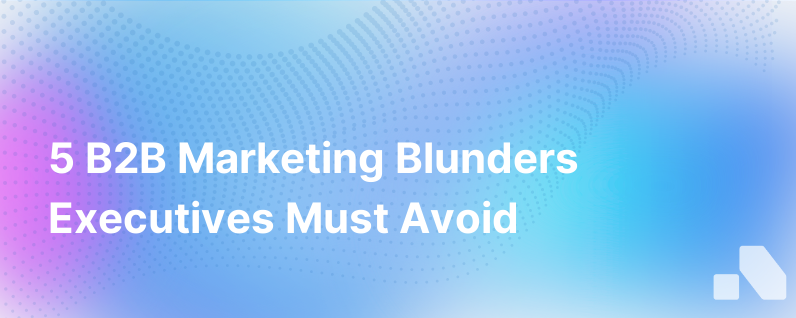5 Common B2B Marketing Mistakes Digital Advertising
Published on September 4, 2023 by Sawyer Middeleer
In the realm of B2B marketing, digital advertising holds vast potential. However, it's often fraught with challenges that can hamper success. Whether it's a misaligned strategy, inadequate targeting or neglecting data, even the most well-intentioned campaigns can fail to deliver expected results if these mistakes aren't mitigated.
Below, we explore five common pitfalls that B2B marketers encounter in digital advertising and discuss strategic approaches to avoid or correct them.
1. Ignoring the Complex B2B Sales Cycle
Transitioning from traditional to digital advertising often comes with the misconception that results will be immediate. In the B2B sector, that's rarely the case. The sales cycle is typically long and complex, involving multiple stakeholders and decision-makers.
Outcome of this Mistake:
- Pushing for quick wins rather than nurturing leads
- Failing to provide content that caters to different stages of the buyer journey
- Inadequate retargeting and follow-ups that may prompt leads to grow cold and lose interest
Strategic Remediation: Align your digital advertising efforts with the typical B2B purchase timeline. Leverage analytics to understand at what points in the funnel prospects are engaging or dropping off, and tailor your advertising to maintain engagement throughout the entire cycle.
2. Generalized Messaging to Diverse Audiences
Marketers often make the mistake of casting a wide net with their digital ads, hoping to catch as many leads as possible. However, B2B audiences are diverse and segmented. Roles within industries vary widely, and stakeholders across levels and functions have different pain points and priorities.
Outcome of this Mistake:
- Diluted messaging that resonates with no particular audience
- Low conversion rates caused by a lack of relevance to each specific prospect
- Increased ad spend with minimal return on investment
Strategic Remediation: Use segmentation to create specific buyer personas. Tailor your messaging to communicate specific value propositions that resonate with the distinct challenges, goals, and pain points of each segment. Develop separate campaigns that speak directly to each persona's context.
3. Neglecting a Multi-Channel Strategy
One critical mistake is using a single platform for digital advertising. Clients in the B2B space utilize a variety of digital channels, and sticking to one platform can severely limit the reach of campaigns.
Outcome of this Mistake:
- Missed opportunities to engage with prospects across platforms they frequent
- Over-saturation of ads on a single platform, leading to ad fatigue amongst audiences
- Potential brand tunnel-vision that limits varying perspectives on how the product can meet different needs
Strategic Remediation: Adopt a multi-channel approach that leverages email, search engines, social media (LinkedIn is crucial for B2B), and retargeting networks. Be mindful of where your target audience spends time and ensure your presence is strong and consistent across those platforms.
4. Underestimating the Importance of Content
Content is the fuel for digital advertising. In B2B marketing, however, there is often a focus on the features and functions of the product or service, which may result in dry or overly technical ads that fail to engage the target audience.
Outcome of this Mistake:
- Advertising that doesn't intrigue or educate, leading to low engagement rates
- Prospective clients failing to recognize the full benefits or use cases of the offerings
- Lackluster brand perception, with potential clients viewing the company as out of touch or behind the times
Strategic Remediation: Invest in high-quality, relevant, and engaging content that speaks to the industry challenges your prospects face. Utilize storytelling to convey the value of your offer and use a mix of formats – from video and infographics to whitepapers and case studies – to cater to various consumption preferences.
5. Overlooking Analytics and Performance Data
Finally, while data is abundant in digital marketing, B2B marketers often fall short when it comes to data analysis. Without a deep dive into performance metrics, it's challenging to gauge the success of campaigns or to identify areas for optimization.
Outcome of this Mistake:
- Persistent investment in underperforming channels without a clear understanding of their ROI
- Inability to refine and improve campaigns over time, leading to stagnant or declining results
- Missed insights into audience behaviors that could inform better decisions in both advertising and product development
Strategic Remediation: Prioritize data analysis to drive decision-making. Set clear KPIs and use tools to track conversions, customer acquisition costs, click-through rates, and other relevant metrics. Conduct A/B tests on various campaign aspects to understand what resonates best with your audience.
In conclusion, B2B digital advertising can be a powerful engine for growth when managed correctly. The path forward involves a keen awareness of the buyer journey, precise targeting, an omnichannel presence, compelling content, and a data-driven approach.
Marketers who navigate these areas effectively can capitalize on the transformative potential of digital advertising, driving sustained demand and creating more opportunities for their sales teams to close deals. Companies like Aomni offer AI-driven tools that can simplify and enhance the entire B2B digital advertising process, ensuring that campaigns are as impactful as possible. They help in obtaining real-time insights for shaping strategies and content that resonates with the target audience, ultimately driving better engagement and conversions. Digital advertising in B2B markets doesn't have to be a guessing game; with the right tools and strategies in place, it can be an engine of predictable, scalable growth.